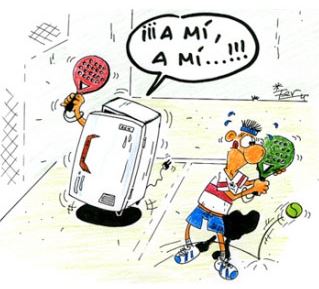introduce
Freeze – Like other sports, padel uses its own slang.
In the vocabulary of padel we can find words that logically do not correspond to their original meaning. such words”Ravibora“,”radomilona“,”Rabandha“…are words that everyone knows, but maybe not everyone knows what exactly they refer to when we use them in padel.
In this article we will discuss one of the following words or expressions used by padel:”Hasel La Nevena” means “freeze a player”
What does it mean to freeze a player?
In padel we say “freeze a player“, by which we mean letting weaker players or players who make more mistakes take the majority of game time.
When this happens, players with few catches can lose interest in the game, become demoralized, and eventually “cool off,” hence the expression.
this “freeze”Therefore, opponents who we consider to be better players suffer (if we do so ourselves).
We can see that this concept refers to the implementation of tactics.
For this “tactic”, we can find two situations:
- We received”freeze” (They always play with my partner, or they always play with me).
- We are doing this to one of our opponents.
We can also distinguish parts “freeze” (pass most of the ball to one player) or total “freeze” (Hit all balls towards one player).
observe
We don’t think we should use that strategy when we have friendlies or training games because everyone wants to play or train, have fun, have fun and pay for the pitch and the ball.
What is the purpose of this tactic?
This tactic has a double aim and will have different effects depending on which of the opposing players we are referring to.
On the one hand, if we mean the player that we carry most of the load in the game, we try to increase the pressure on him by subjecting him to all our blows and attacks, thus sending the message to him that the game depends on him, confirmed He is the weakest of the two and wears him down physically and mentally.
On the other hand, if we mean a player who barely touches the ball, we try to take him out of the game, make him lose interest in the game, make him hopeless, make him anxious about touching the ball at all costs, keep him inactive , so that he can calm down, get impatient or worsen his game.
Pros and Cons of Freezing Outs for Players Who Receive All Balls:
advantage:
- He knew in advance that he had to be on high alert at all times because they were almost certain to pass him the ball.
- His consecutive games allow him to become more and more confident in his shooting and eventually play well.
- In some cases, the situation may have fueled his drive and pride to win at all costs.
shortcoming:
- Having to endure such a large amount of play can be detrimental to physical health.
- May lead to an increase in the stress he feels, either from the situation or from his own partner.
- This affects his emotions as he clearly sees himself as the “worst” of the two.
Tips when we receive frozen information:
Keep in mind that being frozen during a match is very common and normal.
While this may seem obvious, it’s important to remember that being frozen is not something personal. Keeping this in mind, facing the freeze will allow us to face it in a more calm, restful and effective way.
Analyze how the game is going.
If we’re frozen, but our partner is in good shape and we’re winning, we should keep doing that. What works, don’t change it.
Talk to your partner and decide on a strategy.
Communication and rapport with your partner is crucial.
Our partner may have all the balls, but he may not think so. Or our partner may decide that continuing to receive all the balls is the best thing for the game.
When faced with a freeze, talk to your partner, analyze the situation and make a plan. If that plan doesn’t work, change it and find another one.
Try to stay in touch with the focus and the game.
We have to try to stay in the game, stay in every point, not lose focus and drive even if we don’t get any balls. At this point, it helps to keep your partner informed of what your opponent is doing.
If we quit the game, when we touch the ball, we’re likely to miss it because we’re not paying attention to it.
keep Calm.
Players who don’t touch a single ball can easily become impatient and irritated. This can lead to him playing fast and wanting to touch the ball any way he can to try and score points without analyzing whether he’s in good shape to try to do so. This can cause him to push the ball to the max, make a lot of mistakes in logic, and lose confidence.
Always be active.
This means always moving and waiting to try and intercept your opponent’s ball. Show your opponents that you are there and that if they get a good shot, you will go for the ball. This way, you’ll also help your partner cover less space and force your opponent to take bigger risks so you don’t catch them.
Exhibit a positive attitude.
Even if we feel it, we should not show negative emotions such as hopelessness, apathy, boredom, anxiety, etc. to our opponents. This will confirm to them that your strategy is working.
Support your teammates.
The receiving partner must be encouraged and reassured so that they can cope with the situation and all that it entails as best they can.
Avoid comments like: “Don’t worry, just leave it to me, I’ll take care of everything”, “Hand me all the balls and I’ll take care of the game”…instead of comments like this, you should upvote Sexual comments, and give them specific instructions to counteract the freeze (next point).

How to try to counteract “freezing”.
Have a partner play in parallel.
It’s always easier and safer to play cross-court because we have more distance in front of us and the net is lower.
So if our partner is the receiver of all the balls, he/she should try to hit more parallel balls where possible, as this creates a greater risk of forcing or facilitating the opponent’s slash .
Play further than your buddies.
If our partner is in front of the net and we stay behind, there is generally a better chance that the opponent will hit us because our volleys can do more damage.
If they still continue to play against our partners, at least, if they are at the net, they can be more aggressive, put more pressure on the opponent and make it harder for them to control their shots. If they hit a lob and pass the ball over the top, we can catch the ball and get to the point.
Hit more damaging shots.
If our ball is easy and doesn’t cause any damage, it will be easy for our opponent to lead the ball to our weaker opponent. That’s why we have to put as much pressure on them as possible to make it difficult for them to hit our ball back. So their first priority is to try to return the ball, not hit the ball to our partner.
Have your best player play on your backhand side.
That way, it’s easier for him to catch the ball in the middle and have a chance to hit it well because he’s on the good side with both his forehand and backhand.
Not playing Aussie style.
The fact of always playing on the same side makes it easier for our opponents to pass the ball to the weakest player because he is always in the same place. On the other hand, if we switch sides at every point when we serve, we force our opponents to change the direction of the shot, which will mean they are not always as effective at directing the ball.
Even at the same point, it would be nice to switch sides with our partner if there is a possibility of doing so because our lob gets passed.
We should also freeze them.
If they keep us out despite applying all the points above, then we can keep them out as well. Whenever possible, it’s best to do this with the player in front of the player who didn’t catch the ball.
Tips on how to perform a good freeze.
- 80%-20% or 70%-30% ratio.
Many coaches agree that a complete freeze is not the best practice.
If we hit all the balls to one player or increase that ratio, in many cases that player ends up playing better because he has a lot of tempo, so the freeze won’t be as effective anymore.
Plus, if we always hit the ball to the same player, the opponent already knows where we’re going to hit, and we lose the element of uncertainty.
- Play simple balls to better players.
- When under pressure, play difficult shots to weaker opponents.
- If freezing gives us good results, keep doing it and don’t change it.
in conclusion:
Freezing is a very common and widely used tactic in cricket, especially in amateur cricket.
However, executing it successfully is not always an easy task. In order to execute it effectively, it is essential to have the proper technical resources, always have the direction of the ball, communicate well with your partner and follow the same execution plan.
While we’ve seen that there are some guidelines and tricks that can help us avoid or counteract being frozen, the most effective way to avoid this is when paired with two players of the same level. The bigger the level difference between the two players, the more likely we are to be frozen.
More paddle board tips: here
Learn more about PADEL: here







